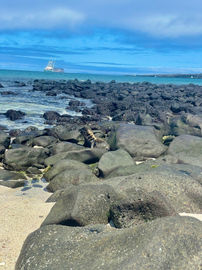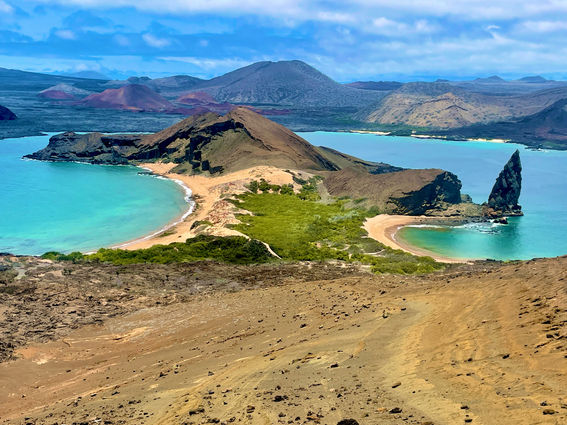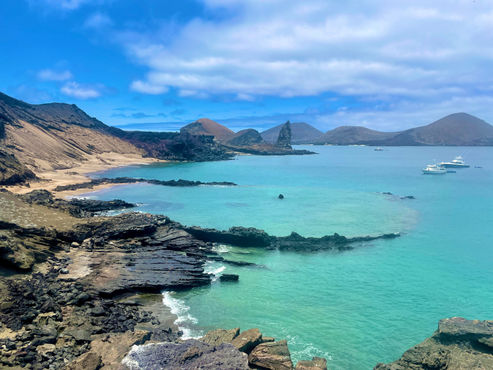
GALAPAGOS ISLANDS
Discovering the Galápagos Islands is like stepping into a real-life nature documentary, where curious sea lions become your swimming buddies and giant tortoises are the OG slow travel influencers. It's not just a trip; it's a whimsical journey through a land where every creature has its own enchanting story to tell.
CHECK OUT OUR TRIP TO THE GALAPAGOS
THE HIGHLIGHTS

Tortuga Bay (Bahia Tortuga) is a beach on Santa Cruz Island in the Galápagos Islands. It's known for its white coral sand, clear blue water, and 1.55 mile walking path.
Tortuga Bay

Bartolomé Island is a volcanic islet in the Galápagos Islands group, just off the east coast of Santiago Island. It is one of the "younger" islands in the Galápagos archipelago. Great for snorkling excursions. Chance to see penguins, seals, and sea turtles.
Isla Bartolomé

Puerto Ayora is a town in central Galápagos, Ecuador, located on the southern shore of Santa Cruz Island. It's the economic center of the Galápagos, and the main tourism hub in the archipelago. The world-famous tortoises are here!
Puerto Ayora, Santa Cruz

North Seymour Island is a small island in the Galápagos Islands, Ecuador. It's located in a central position in the archipelago, close to Baltra and Santa Cruz Islands. Tours include both island walks and snorkling.
Seymour Island
Check out all the incredible experiences you can have on your journey to get a taste of what might ignite your own wanderlust!

The Daphnes include two islands, Daphne Major and Daphne Minor, just north of Santa Cruz. Both are tuff cones and are completely devoid of trees. Access to Daphne Major is restricted by the Galápagos National Park, and it may only be visited with a special permit. You can boat past them in excursions. You will see Galapagos puffins & Blue-footed Boobies here.
Daphne Major & Minor

Española is sometimes considered the jewel of the Galapagos due to its many natural wonders. It is the only place in the world where you can find a waved albatross nest. Every waved albatross flocks here during the mating season, from April to December. Watch their curious mating ritual which involves waddling, bill circling, and strange noises. Once a pair has bonded, they remain mates for life.
Española Island

Isabela, the largest Galapagos island, is a seahorse-shaped marvel formed by six active volcanoes, including the highest point, Wolf Volcano. Famous for hosting more giant tortoise types than all other islands combined, Isabela's unique landscape includes Sierra Negra, with the world's second-largest active crater. Explore the gentle giants at the Tortoise Center of Isabela.
Isabela Island

San Cristobal, the easternmost island of the Galapagos, is not only one of the oldest, formed by extinct volcanoes, but it's also the first to be permanently inhabited. Its attraction includes the only freshwater lake in the region, El Junco, making it the second-most populous island, with Puerto Baquerizo Moreno as its capital, boasting picturesque views and a rich history showcased at the San Cristobal Interpretation Center.
San Cristobal Island

Genovesa, the "bird island" of the Galapagos, is a horseshoe-shaped haven in the north, known for diverse bird species like frigatebirds and red-footed boobies. May brings unique mating rituals, while Darwin Bay offers pristine beaches and excellent snorkeling with sea turtles and the chance to spot hammerhead sharks.
Genovesa Island

Fernandina, the youngest Galapagos island, features the active La Cumbre volcano, creating a barren landscape with mangroves, lava cacti, and unique flightless cormorants. Punta Espinosa, its sole visitor site, offers a stark jet-black terrain, abundant marine life, and the largest colony of marine iguanas.
Fernandina Island

Plaza Sur, near Santa Cruz, is a small yet vibrant island in the Galapagos, home to diverse seabirds, including dancing blue-footed boobies. With rare hybrid iguanas, one of the largest sea lion colonies, and a colorful landscape changing with the seasons, Plaza Sur is a must-visit accessible through day trips or cruises.
Plaza Sur Island

Floreana was the first island to be visited by humans. Yet, without a source of freshwater, the remaining population today is less than 200. Most of the people here live in Puerto Velasco Ibarra, a small outpost on the western coast of the island. There are a couple of hotels and restaurants, though tourist facilities are very limited.
Floreana Island

Santa Fe Island, a short boat trip from Puerto Ayora, is considered the oldest in the Galapagos, hosting endemic species like the rare Santa Fe iguana and the Galapagos hawk. With its unique wildlife, including playful Galapagos sea lions on the turquoise Barrington Bay beaches, the island offers a glimpse into the archipelago's evolutionary history.
Santa Fe Island

Rábida's iconic red beach, shaped by high iron content, is a photogenic spot for sunbathing sea lions and marine iguanas. Snorkel in the turquoise sea for encounters with diverse marine life. The inland trail leads to a saltwater lagoon with flamingos and showcases birdwatching opportunities, making Rábida a captivating destination for nature enthusiasts.
Rábida Island

























